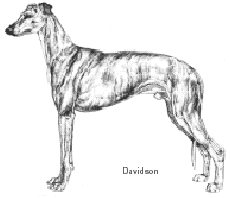Greyhound
General Information - Greyhound

Group:
Hound
Size:
large
Lifespan:
10-13 years
Exercise:
moderate
Grooming:
very low
Trainability:
medium
Watchdog ability:
high
Protection ability:
low
Area of Origin:
Middle East ,however
the area of development is recognised as being England
Date of Origin:
ancient times
Other Names:
none
Original Function:
Hunting small and
large
History
The Greyhound is said to be the oldest pure breed in existence today. Records dating back from 4000 to 7000 years depict the Greyhound much as it is today. The breed originated in the Middle East and travelling nobles brought the dogs with them as gifts of esteem. In this way, the breed spread throughout the European continent and the Orient long before Christianity. The breed's main function was as a sporting and hunting dog. It was used to hunt stag, fox, gazelle, and hare. In Britain, in 1858, the National Coursing Club was formed, and the Greyhound was one of the main contenders in the sport. Shortly after, Greyhound racing became popular in England, the States and Australia and was seen as a more humane sport, as the dogs chased a mechanical lure as opposed to a live hare. While the breed is not suited to confined living conditions, it makes an excellent family member. It still maintains its original instincts to run and hunt, therefore regular, supervised outdoor runs are required.
Temperament
Sweet and loving, Greyhounds make excellent companions. They are gentle and even-tempered and should be socialised early to avoid timidity. Greyhounds are very loyal and love their masters and their families. Ex-Racers also make good pets and are easy to housebreak.
Upkeep
The Greyhound needs daily exercise, but it is a sprinter, not an endurance runner. Its needs can thus be met with a chance to run, or by a longer walk on leash. It loves to run and chase outdoors, and can easily run into danger at great speed unless exercised in a safe area. It is not generally amenable to living outdoors. Greyhounds relish creature comforts and must have soft bedding and warmth. The coat is extremely easy to care for, needing only occasional brushing to remove dead hair.
Greyhound
A breed standard is the guideline which describes the ideal characteristics, temperament, and appearance of a breed and ensures that the breed is fit for function with soundness essential. Breeders and judges should at all times be careful to avoid obvious conditions and exaggerations, as well as being mindful of features which could be detrimental in any way to the health, welfare or soundness of this breed.
Breed Standard - Greyhound
 Characteristics
Characteristics: The Greyhound possesses remarkable stamina and endurance, its straight through, long reaching movement enables it to cover ground at great speed.
General Appearance: The general appearance of the typical Greyhound is that of a strongly built, upstanding dog of generous proportions, muscular power and symmetrical formation, with a long head and neck, clean well: laid shoulders, deep chest, capacious body, arched loin, powerful quarters, sound legs and feet, and a suppleness of limb, which emphasize in a marked degree its distinctive type and quality.
Head and Skull: Long, moderate width, flat skull, slight stop. Jaws powerful and well chiselled.
Eyes: Bright and intelligent - oval - set obliquely.
Ears: Small, rose-shape of fine texture.
Mouth: Teeth white and strong. The incisors of the upper jaw clipping those of the lower jaw.
Neck: Long and muscular, elegantly arched, well let into the shoulders.
Forequarters: Shoulders, oblique, well set back, muscular without being loaded, narrow and cleanly defined at the top. Forelegs, long and straight, bone of good substance and quality. Elbows free and well set under the shoulders. Pasterns, moderate length, slightly sprung. Elbows, pasterns and toes should incline neither outwards nor inwards.
Body: Chest, deep and capacious, providing adequate heart room. Ribs, deep, well sprung, and carried well back. Flanks well cut up. Back, rather long, broad and square. Loin, powerful, slightly arched.
Hindquarters: Thighs and second thighs, wide, and muscular, showing great propelling power. Stifles well bent. Hocks, well let down, inclining neither outwards nor inwards. Body and hindquarter features should be of ample proportions and well coupled, enabling adequate ground to be covered when standing.
Feet: Moderate length, with compact well:knuckled toes, strong pads.
Tail: Long, set on rather low, strong at the root, tapering to the point, carried low, slightly curved.
Coat: Fine and close.
Colour: Black, white, red, blue, fawn, fallow, brindle, or any of the colours broken with white.
Gait: Straight, low reaching free stride enabling it to cover ground at great speed. Hind legs should come well under body giving great propulsion.
Height: Ideal height dogs 71 - 76 cm (28 - 30 in); bitches 68 - 71 cm (27 - 28 in).
Note: Male animals should have two apparently normal testicles fully descended into the scrotum.
DNZ No 468
Copyright Dogs New Zealand
01 Jan 2002
Any departure from the foregoing points should be considered a fault and the seriousness with which the fault should be regarded should be in exact proportion to its degree and its effect upon the health and welfare of the dog and on the dog’s ability to perform its traditional work.




